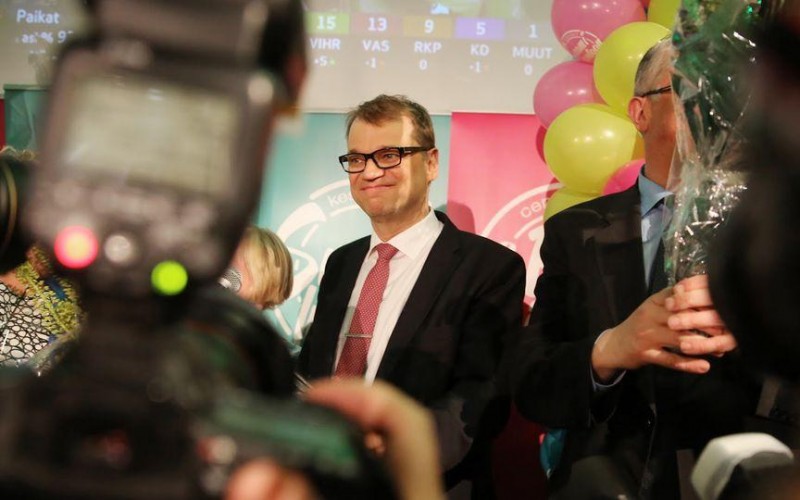Finland’s Prime Minister-elect Juha Sipilä has the difficult task of forming a new government, but he is determined to create a small, efficient coalition that can push through with quick reforms.

During Finland’s parliamentary elections last Sunday, most Finns voted for the right-of-center and somewhat agrarian Centre Party, whose success was long predicted by national polls. Juha Sipilä, the party chair and self-made IT millionaire, will be given the task of forming the next government.
In second place came the eurosceptic Finns Party, which was closely tailed by the incumbent Prime Minister Alexander Stubb’s National Coalition Party. In total, 8 parties gained seats in the Parliament, all of which traditionally have a fair chance of being asked to join the government.
Since electing the outgoing government into power in 2011, Finns have grown tired of its perceived inability to tackle important issues. Initially a motley crew of 6 parties ranging the entire political spectrum, the government has been unable to boost Finland’s stagnating economy. As a result, Finnish GDP is still lower than at its 2008 peak.
Hit with a combination of the Eurocrisis, an aging population, and international sanctions against one of its main trading partners, Russia, Finland is in desperate need of strong, robust action. However, the current government has notably failed to commit to spending cuts, or to see through vital reforms in health care and local government budgets. Consequently, Finland’s budget deficit is predicted to pass the EU limit of 60% of GDP later this year.
Most people blame the government’s lack of efficiency on its size and spread of competing interests. With so many rivaling voices, it has been hard to reach clarity and consensus. As a sign of this internal discord, both the Green Party and the Left Alliance quit the government in 2014.
Less is more
In light of this, many have seen the election results as a protest against the incumbent, dysfunctional government. Indeed, both the Centre Party and the Finns Party seem to have benefited from being in the opposition, together gaining nearly 40% of the votes.
According to protocol, Mr. Sipilä will be asked to begin coalition negotiations next Tuesday, and he often stated during his campaign that he is willing to team up with any of the other parties. But after receiving such a clear mandate from the Finnish public, Mr. Sipilä is in a solid position to pick and choose his partners. His party is also seen as relatively easy to work with, and the other party leaders have expressed eagerness to cooperate.
In general, Sipilä is determined to push through structural reforms as soon as possible. One of his solutions to achieve this is to form a narrower government, and he is likely to invite only 2 or 3 other parties to join his coalition.
In particular, Mr. Sipilä has named three factors for choosing his partners: most important is mutual trust and consensus on a government programme, with election results a secondary consideration. Sipilä has also decided to take inspiration from his business background, and aims to form a goal-oriented cabinet with “collegiate ties” that will focus on 5-7 main strategic targets. He has also decided to slim down the number of ministers from 17 to 12.
A leaner, cleaner Finnish economy
During the election campaign, the Centre Party made a continuous guarantee that they can get the Finnish economy ‘back into shape’. This includes the pledge to create 200,000 jobs, increase investment in innovative technologies and businesses, and cut the public sector’s budget by €3 billion over the next few years.
In support of Sipilä’s aims, virtually all the other parties have also agreed on the need to cut the government’s deficit, which could make forming a strategic government programme easier.
The Centre Party has also referred to the need for labour market reforms to spur competitiveness, as well as tackling the inherent bureaucracy in political leadership. Furthermore, the Party has outlined the need to focus on sustainable development, including an emphasis on renewable energy, a cyclical economy, and biotechnology.
The aim is to help boost the economy via green growth and creating green jobs. Many of the other parties are also open to this idea, particularly the Green Party, which was the only other party to actually gain seats in the elections.
Creating a coalition in Finnish politics is never an easy task. For instance, it took the previous Prime Minister Jyrki Katainen 2 months to form a government. But with Mr. Sipilä’s strong mandate and proactive leadership style, he is confident he can have a government ready within the month.
Yet more important than speed is quality. By prioritizing a tight-knit government that agrees on important positions beforehand, we can expect the new Finnish government to respond to problems quickly and effectively. Certainly, if any of Mr. Sipilä’s direction and drive can translate into action, we may see Finland regaining its economic stability sooner rather than later.
sourche: http://globalriskinsights.com/2015/04/can-a-new-prime-minister-bring-the-rebound-finland-needs/
Δεν υπάρχουν σχόλια:
Δημοσίευση σχολίου